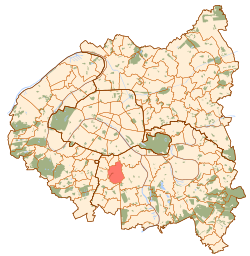Villejuif
Villejuif | |
|---|---|
| Institut Gustave-Roussy - Main Building Institut Gustave-Roussy - Main Building | |
 Paris and inner ring departments | |
| Country | France |
| Region | Île-de-France |
| Department | Val-de-Marne |
| Arrondissement | L'Haÿ-les-Roses |
| Canton | Villejuif-Est (Chef-lieu) Villejuif-Ouest (Chef-lieu) |
| Intercommunality | Val de Bièvre |
| Government | |
| • Mayor | Franck Le Bohellec |
| Area 1 | 5.34 km2 (2.06 sq mi) |
| Population (2008) | 53,240 |
| • Density | 10,000/km2 (26,000/sq mi) |
| Time zone | UTC+01:00 (CET) |
| • Summer (DST) | UTC+02:00 (CEST) |
| INSEE/Postal code | 94076 /94800 |
| Elevation | 62–130 m (203–427 ft) |
| Website | [1] |
| 1 French Land Register data, which excludes lakes, ponds, glaciers > 1 km2 (0.386 sq mi or 247 acres) and river estuaries. | |
Villejuif (pronounced [vilʒɥif]) is a commune in the southern suburbs of Paris, France. It is located 7 km (4.3 mi) from the centre of Paris.
Name
The name Villejuif can be imprecisely translated as "Jew Town", but the area has no historical connections with the Jewish population of Paris. The name is believed to be a corruption of a Gallo-Roman name, Ville Juvius, meaning the villa of Juvius.[1]
Demographics
Population
| Year | Pop. | ±% |
|---|---|---|
| 1793 | 1,362 | — |
| 1800 | 1,137 | −16.5% |
| 1806 | 1,320 | +16.1% |
| 1821 | 1,278 | −3.2% |
| 1831 | 1,377 | +7.7% |
| 1836 | 1,652 | +20.0% |
| 1841 | 1,503 | −9.0% |
| 1846 | 1,587 | +5.6% |
| 1851 | 1,514 | −4.6% |
| 1856 | 1,559 | +3.0% |
| 1861 | 1,813 | +16.3% |
| 1866 | 2,308 | +27.3% |
| 1872 | 1,917 | −16.9% |
| 1876 | 2,117 | +10.4% |
| 1881 | 2,678 | +26.5% |
| 1886 | 3,163 | +18.1% |
| 1891 | 4,294 | +35.8% |
| 1896 | 5,234 | +21.9% |
| 1901 | 5,835 | +11.5% |
| 1906 | 6,600 | +13.1% |
| 1911 | 8,671 | +31.4% |
| 1921 | 11,725 | +35.2% |
| 1926 | 18,751 | +59.9% |
| 1931 | 25,192 | +34.4% |
| 1936 | 27,540 | +9.3% |
| 1946 | 25,359 | −7.9% |
| 1954 | 29,280 | +15.5% |
| 1962 | 46,116 | +57.5% |
| 1968 | 51,120 | +10.9% |
| 1975 | 55,606 | +8.8% |
| 1982 | 52,448 | −5.7% |
| 1990 | 48,405 | −7.7% |
| 1999 | 47,384 | −2.1% |
| 2006 | 51,739 | +9.2% |
Immigration
| Born in metropolitan France | Born outside metropolitan France | |||
|---|---|---|---|---|
| 76.1% | 23.9% | |||
| Born in overseas France |
Born in foreign countries with French citizenship at birth1 | EU-15 immigrants2 | Non-EU-15 immigrants | |
| 2.8% | 2.9% | 5.6% | 12.6% | |
| 1 This group is made up largely of former French settlers, such as pieds-noirs in Northwest Africa, followed by former colonial citizens who had French citizenship at birth (such as was often the case for the native elite in French colonies), as well as to a lesser extent foreign-born children of French expatriates. A foreign country is understood as a country not part of France in 1999, so a person born for example in 1950 in Algeria, when Algeria was an integral part of France, is nonetheless listed as a person born in a foreign country in French statistics. 2 An immigrant is a person born in a foreign country not having French citizenship at birth. An immigrant may have acquired French citizenship since moving to France, but is still considered an immigrant in French statistics. On the other hand, persons born in France with foreign citizenship (the children of immigrants) are not listed as immigrants. | ||||
Transport
Villejuif is served by three stations on Paris Métro Line 7: Villejuif – Léo Lagrange, Villejuif – Paul Vaillant-Couturier, and Villejuif – Louis Aragon.
Personalities
- Camille Loiseau, the Doyenne de France from 26 March 2005 to 12 August 2006, died at the Hôpital Paul-Brousse in Villejuif.
- Issei Sagawa, the Japanese killer and cannibal, was an inmate at high-security Paul Guiraud hospital in Villejuif, in 1982–1984.
- Komitas Vardapet, the founder of modern Armenian classical music.
- Vladimir Ghika, Catholic parish priest from 1923-1930, killed in Romania in 1954, beatified 31 August 2013.
Hospitals
Villejuif has many hospitals on its territory :
- the Institut Gustave Roussy, leading hospital in oncology in Europe
- the Hôpital Paul-Brousse
- the Paul Guiraud hospital
Education
13 preschools, 11 elementary schools, and five junior high schools (Collège Aimé-Césaire, Collège Guy-Môquet, Collège Jean-Lurçat, Collège Karl-Marx, Collège Pasteur) are in Villejuif. Lycée intercommunal Darius-Milhaud (in Le Kremlin-Bicêtre) serves Villejuif.[2]
Other institutions:
Twin cities
 Dunaújváros, Hungary
Dunaújváros, Hungary Mirandola, Italy
Mirandola, Italy Neubrandenburg, Germany
Neubrandenburg, Germany Vila Franca de Xira, Portugal
Vila Franca de Xira, Portugal Yambol, Bulgaria
Yambol, Bulgaria
See also
References
- ^ Pierre Hentgès, "Note sur la signification de Villejuif", in Villejuif, notre cité, 1975, p. 235-238
- ^ "Etablissements scolaires." Villejuif. Retrieved on June 23, 2015.
External links


